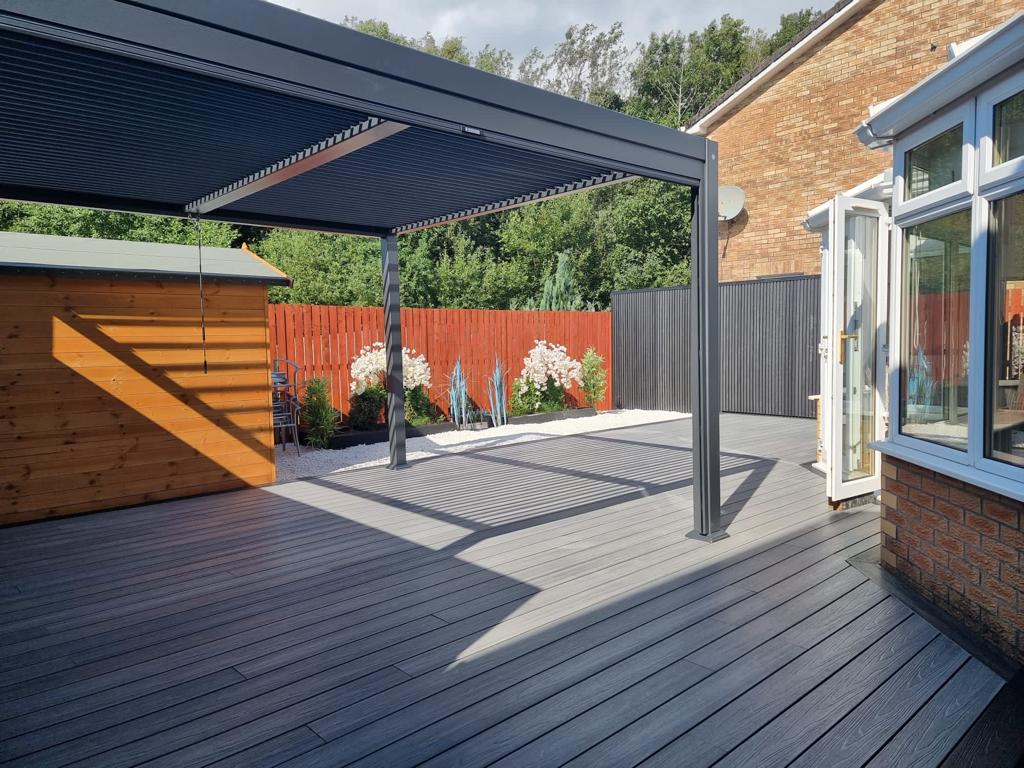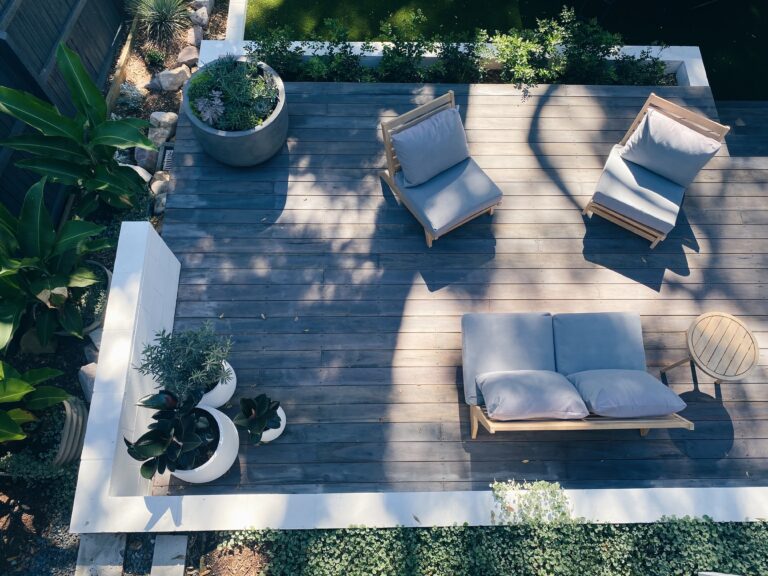Composite decking has become a popular choice for outdoor decking due to its low maintenance, durability, and environmental friendliness. With a variety of colours and styles available, it offers a versatile option for enhancing outdoor spaces. But can you put composite decking over wood? This article will explore the benefits of composite decking, considerations for installing it over wood, and alternative solutions for upgrading your outdoor space.
Whether you’re looking to refresh an existing wood deck or explore other options, this article will guide you through the process and help you make an informed decision.

What is Composite Decking?
Composite decking is a versatile and durable alternative to traditional wood decking, made from a combination of wood fibres and recycled plastic materials.
It offers a low-maintenance solution for outdoor living spaces, as it is resistant to rot, warping, and splintering. The construction process involves blending the wood fibres and recycled plastic with a binding agent to form a sturdy and long-lasting material. Its eco-friendly attributes lie in the utilisation of recycled materials, reducing the demand for virgin wood and minimising plastic waste. This makes composite decking a sustainable choice for environmentally conscious homeowners seeking a beautiful and enduring outdoor surface.
What are the benefits of composite decking?
Composite decking offers numerous benefits, including:
- Exceptional durability
- Weather resistance
- Low maintenance requirements
Making it an attractive choice for outdoor living spaces.
Low Maintenance
One of the key benefits of composite decking is its low maintenance nature, requiring minimal cleaning, staining, and sealing compared to traditional wood decks.
Regular cleaning of composite decking can be done with a gentle soap and water solution and a soft brush to remove any dirt or debris. Unlike wood decks that require annual staining or sealing to maintain their appearance and resist deterioration, composite decking typically only needs occasional cleaning to keep its attractive look. This low maintenance aspect not only saves time and effort but also minimises the need for ongoing costly maintenance products, making composite decking a practical and convenient option for outdoor spaces.
Long-lasting
Composite decking is renowned for its durability, offering a long lifespan, high performance, and UV protection to withstand various environmental conditions.
Its enhanced durability enables it to resist rotting, warping, and splintering, ensuring a longer-lasting solution compared to traditional wood decking. With its exceptional resistance to fading from UV exposure, composite decking maintains its colour vibrancy for years, requiring minimal maintenance. This longevity and resilience make it an ideal choice for outdoor spaces, providing a reliable and enduring investment for homeowners.
Environmentally Friendly
An important advantage of composite decking is its environmentally friendly nature, promoting sustainability and minimising environmental impact through the use of recycled materials.
By utilising recycled plastic and wood fibres, composite decking not only reduces the demand for virgin materials but also prevents waste from ending up in landfills. This sustainable approach contributes to the preservation of natural resources while also reducing the need for maintenance with its durable qualities. With the added benefit of being resistant to rot, mould, and insect damage, composite decking offers a long-lasting and eco-friendly alternative to traditional wood decking.
Variety of Colors and Styles
Composite decking offers a wide range of colours and styles, providing diverse aesthetic options for outdoor living spaces, making it a versatile choice for personalised design.
These options include traditional wood tones, modern greys, rich browns, and even vibrant reds or blues, allowing homeowners to customise their deck to match their individual taste and complement their home’s exterior.
Composite decking can mimic the look of natural wood or offer a sleek, contemporary appearance, catering to a variety of architectural styles and personal preferences. With such versatility, composite decking presents an attractive and durable solution for enhancing outdoor spaces.
Can you lay composite decking over wood?
Considering installing composite decking over existing wood? Let’s explore the possibilities and considerations of this home improvement project.
When transitioning from wood to composite decking, it’s important to assess the condition of the existing structure to ensure compatibility. The installation process typically involves removing the old decking, inspecting the substructure, and making any necessary repairs or adjustments to accommodate the new composite materials. Homeowners often appreciate the low maintenance aspect of composite decking, as it resists rot, warping, and insect damage, providing a long-lasting and durable outdoor living space.
With a wide range of colours and textures available, composite decking can significantly enhance the aesthetic appeal and value of the property.
Yes, but with reservations
Yes, it is possible to install composite decking over timber, but certain factors related to the condition and structure of the existing timber deck must be considered for a successful renovation.
The feasibility of installing composite decking over timber depends on the stability and integrity of the underlying timber structure. It is important to assess the existing timber for any signs of decay, rot, or structural issues.
The installation process may require adjustments to accommodate the differences in materials and ensure proper support. Factors such as joist spacing, ventilation, and clearance must also be taken into account to achieve a durable and visually appealing result.
Verify the Structural Integrity
Before proceeding with composite decking installation over wood, it is crucial to assess the structural integrity of the existing wood deck and ensure its moisture resistance capability.
This assessment is vital to ensure that the underlying structure can support the added weight and durability of composite decking. Verifying the moisture resistance helps in preventing potential issues such as rot, mould, and decay, which can compromise the longevity and stability of the new decking material.
By taking these precautionary measures, homeowners can make informed decisions and ultimately enjoy a durable and long-lasting composite decking installation.
Remove old decking if necessary
In some cases, it may be necessary to remove the old decking before installing composite decking to ensure a proper and seamless process.
This is particularly important when the old decking is in poor condition or is not structurally sound. By removing the old decking, you can assess the state of the underlying structure and make any necessary repairs or replacements, ensuring that the new composite decking is installed on a sturdy and stable base.
Removing the old decking allows for a clean and level surface, providing better adhesion for the new composite boards and ensuring a professional finish.
Consider the Height Difference
When installing composite decking over timber, it is important to consider the potential height difference and address proper levelling to achieve a uniform and aesthetically pleasing result.
Ensuring an even surface is crucial not only for the visual appeal but also for the structural integrity of the decking. Proper levelling techniques, such as using adjustable pedestals or shims, can help to mitigate any height variations. Checking the existing timber substructure for any signs of decay or rot is essential to prevent future issues. By integrating these considerations into the installation process, you can ensure a seamless transition from timber to composite decking.
What Are The Steps For Installing Composite Decking Over Wood?
Embarking on the installation of composite decking over wood involves a series of essential steps to ensure a successful DIY project and an upgraded outdoor living space.
- Begin by removing the old wood decking and ensuring the structural integrity of the underlying joists.
- Next, carefully measure and plan the layout for the new composite decking boards.
- Pre-drill and secure the boards using composite deck screws, ensuring even spacing and a secure fit.
As a final touch, add finishing elements such as trim and railing to complete the transformation. This process not only enhances the aesthetics of your outdoor space but also contributes to the longevity and durability of the decking.
Clean and prepare the surface
The initial step in installing composite decking over wood involves thorough cleaning and surface preparation to ensure optimal adhesion and moisture resistance.
This process is crucial as it helps to remove any existing debris, dirt, or mould that may hinder the adhesion of composite decking. Proper cleaning allows for better penetration of sealants and coatings, enhancing the surface’s moisture resistance. By ensuring a clean and well-prepared surface, the longevity and performance of the composite decking can be significantly improved, minimising the risk of issues such as peeling, cracking, or warping due to inadequate surface preparation.
Install Support Joists
Constructing a solid foundation for the composite decking involves the installation of support joists to provide structural stability and ensure a robust upgrade for the outdoor living space.
These support joists are crucial in distributing the weight of the decking material evenly and preventing any sagging or warping over time. They create a sturdy base for the decking boards to be securely attached, enhancing the durability and longevity of the outdoor area.
By carefully aligning and securing the joists, homeowners can enjoy a reliable and long-lasting composite deck that enhances the overall aesthetic and functionality of their outdoor living space.
Lay Down Composite Decking Boards
Once the foundation is prepared, it’s time to lay down the composite decking boards, initiating the construction phase of the project and bringing the vision of an upgraded outdoor space to life.
These decking boards are carefully placed to create a smooth and visually appealing surface, enhancing the aesthetics of the outdoor area. As each board is set into place, the transformative impact becomes evident, with the space taking on a new, modernised look.
Incorporating the composite material not only ensures durability but also provides a low-maintenance solution, allowing homeowners to enjoy their outdoor space without the hassle of constant upkeep.
Secure and Finish the Decking
The final stage of installing composite decking over wood involves securing the boards and applying finishing touches to enhance the aesthetics and functionality of the outdoor living space.
This critical phase not only ensures the structural stability and safety of the deck but also plays a pivotal role in elevating its visual appeal and longevity. Properly secured boards prevent shifting or warping over time, whilst the application of finishing touches such as trim, railings, and coatings adds finesse and protection. These final touches not only complement the overall design but also contribute to the durability and weather resistance of the deck, creating a welcoming and enjoyable outdoor haven for years to come.
What are the alternatives to installing composite decking over wood?
Exploring alternative options to installing composite decking over wood can provide insights into wood replacement and cost-effective upgrade projects for outdoor living spaces.
One popular alternative to installing composite decking over wood is to replace the existing wood decking with composite material. This option allows homeowners to enjoy the benefits of composite decking without the need to remove the entire structure. This approach can be a cost-effective way to upgrade outdoor living spaces, as it provides the aesthetic appeal and durability of composite decking without the expense of a complete overhaul.
Another option is to explore low-maintenance wood replacement materials, such as PVC decking, which offers a similar look to wood but with enhanced durability and minimal upkeep requirements.
Remove Old Decking and Install New Composite Decking
One alternative approach involves removing the old decking and initiating a project to install new composite decking, which can revitalise the outdoor living space with enhanced durability and aesthetics.
This renovation not only modernises the appearance of the outdoor area but also eliminates the maintenance hassles often associated with traditional wood decking. With composite decking, the need for regular staining, sealing, or sanding diminishes, allowing homeowners to spend more time enjoying their outdoor space.
The high-quality materials used in composite decking offer superior resistance to fading, staining, and mould, ensuring a long-lasting and visually appealing enhancement to the outdoor living space.
Install Composite Decking on Top of a Concrete Patio
Considering the installation of composite decking on top of a concrete patio presents a DIY building opportunity to transform the outdoor living space with a durable and visually appealing upgrade.
This project provides an excellent way to revitalise a drab concrete patio, creating an inviting and stylish area for relaxation and entertaining. Composite decking offers numerous benefits, including resistance to rot, mold, and pests, while requiring minimal maintenance. Its durable nature ensures longevity, making it a practical and cost-effective investment for outdoor areas.
With the right tools and guidance, the installation process can be manageable for homeowners looking to enhance their outdoor living space.
Utilise Deck Tiles as a Temporary Solution
Utilising deck tiles as a temporary solution provides a versatile and aesthetically pleasing option for renovating outdoor living spaces, offering flexibility and visual enhancement.
These tiles are easy to install and can be placed directly on any hard surface, such as concrete or old decking, instantly transforming the area into a striking outdoor space. With a wide range of material options, from wood to composite, deck tiles offer the opportunity to customise the look and feel of the space to suit any style or design preference. Their temporary nature allows for quick and easy changes, making them an ideal solution for renters or homeowners looking for a flexible and eye-catching outdoor renovation.







